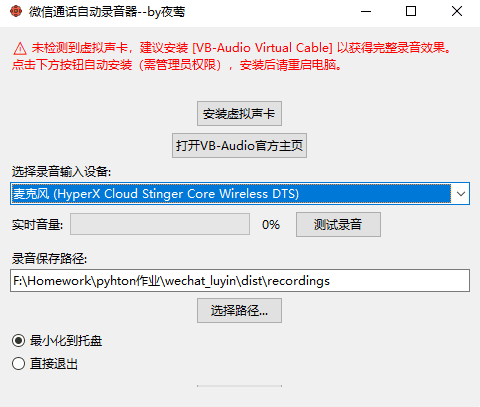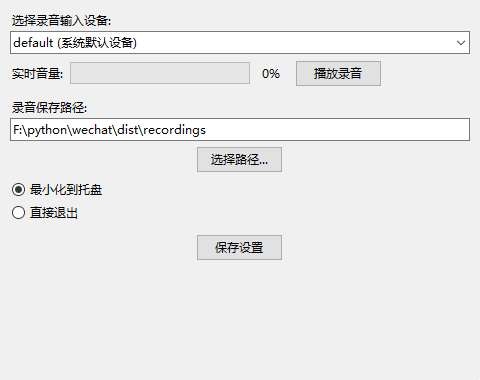微信通话自动录音器
—————【下 载 地 址】———————
【本章下载一】:https://pan.xunlei.com/s/VOVvLpQuRxYadClkxTGwO2OnA1?pwd=vind#
【本章下载二】:https://pan.xunlei.com/s/VOVvLpQuRxYadClkxTGwO2OnA1?pwd=vind#
【百款黑科技】:https://ucnygalh6wle.feishu.cn/wiki/HPQywvPc7iLZu1k0ODFcWMt2n0d?from=from_copylink
—————【下 载 地 址】———————
写在前面 最近在电脑上跟人聊天时发现它不能像手机那样自动录音,找了一圈也没发现类似的软件。于是作为小白的我,在 AI 的帮助下完成了这个工具。如果你也有类似需求,希望这款微信通话自动录音器能帮到你。
软件简介
微信通话自动录音器 是一款支持 Windows 平台的桌面小工具,主要功能包括:
- 自动检测微信的通话窗口(支持语音 / 视频通话)
- 一旦检测到通话,自动开始录音,通话结束自动保存 mp3 文件
- 支持选择麦克风或虚拟声卡(推荐安装 VB-Audio Virtual Cable,可完整捕获 \"你和对方\" 的声音)
- 支持自定义录音保存路径
使用步骤
- 下载并解压本程序(建议放在英文路径下)
- 安装 FFmpeg(用于录音处理,详见下文)
- 安装虚拟声卡(推荐 VB-Audio Virtual Cable)
- 设置系统“侦听”功能(详见下文)
- 双击运行程序,选择输入设备与保存路径
- 最小化后可在系统托盘中运行,程序将自动录音
虚拟声卡安装方法
- 打开官网:[url=]https://vb-audio.com/Cable/[/url]
- 点击 Download 下载压缩包(如 VBCABLE_Driver_Pack43.zip)
- 解压后,右键以管理员身份运行 VBCABLE_Setup_x64.exe
- 点击 Install Driver 并按提示完成安装,重启电脑后生效
系统“侦听”功能设置(非常重要)
- 右键任务栏右下角喇叭图标 → 选择“声音设置”
- 点击右侧“更多声音设置” → 切换到“录制”标签页
- 找到要录音的设备(例如:“麦克风”、“CABLE Output” 等),右键 → 选择“属性”
- 切换到“侦听”标签页 → 勾选“侦听此设备”
- 播放设备选择你常用的扬声器或耳机(建议不要选虚拟声卡)
- 点击“应用” → “确定”
-
[Python] 纯文本查看 复制代码? 001 002 003 004 005 006 007 008 009 010 011 012 013 014 015 016 017 018 019 020 021 022 023 024 025 026 027 028 029 030 031 032 033 034 035 036 037 038 039 040 041 042 043 044 045 046 047 048 049 050 051 052 053 054 055 056 057 058 059 060 061 062 063 064 065 066 067 068 069 070 071 072 073 074 075 076 077 078 079 080 081 082 083 084 085 086 087 088 089 090 091 092 093 094 095 096 097 098 099 100 101 102 103 104 105 106 107 108 109 110 111 112 113 114 115 116 117 118 119 120 121 122 123 124 125 126 127 128 129 130 131 132 133 134 135 136 137 138 139 140 141 142 143 144 145 146 147 148 149 150 151 152 153 154 155 156 157 158 159 160 161 162 163 164 165 166 167 168 169 170 171 172 173 174 175 176 177 178 179 180 181 182 183 184 185 186 187 188 189 190 191 192 193 194 195 196 197 198 199 200 201 202 203 204 205 206 207 208 209 210 211 212 213 214 215 216 217 218 219 220 221 222 223 224 225 226 227 228 229 230 231 232 233 234 235 236 237 238 239 240 241 242 243 244 245 246 247 248 249 250 251 252 253 254 255 256 257 258 259 260 261 262 263 264 265 266 267 268 269 270 271 272 273 274 275 276 277 278 279 280 281 282 283 284 285 286 287 288 289 290 291 292 293 294 295 296 297 298 299 300 301 302 303 304 305 306 307 308 309 310 311 312 313 314 315 316 317 318 319 320 321 322 323 324 325 326 327 328 329 330 331 332 333 334 335 336 337 338 339 340 341 342 343 344 345 346 347 348 349 350 351 352 353 354 355 356 357 358 359 360 361 362 363 364 365 366 367 368 369 370 371 372 373 374 375 376 377 378 379 380 381 382 383 384 385 386 387 388 389 390 391 392 393 394 395 396 397 398 399 400 401 402 403 404 405 406 407 408 409 410 411 412 413 414 415 416 417 418 419 420 421 422 423 424 425 426 427 428 429 430 431 432 433 434 435 436 437 438 439 440 441 442 443 444 445 446 447 448 449 450 451 452 453 454 455 456 457 458 459 460 461 462 463 464 465 466 467 468 469 470 471 472 473 474 475 476 477 478 479 480 481 482 483 484 485 486 487 488 489 490 491 492 493 494 495 496 497 498 499 500 501 502 503 504 505 506 507 508 509 510 importosimportsysimportjsonimportsubprocessimportthreadingimporttimeimporttkinter as tkfromtkinterimportttk, filedialog, messageboximportpygetwindow as gwimportpystrayfromPILimportImage, ImageDrawimportloggingimporttracebackfromlogging.handlersimportTimedRotatingFileHandlerimportctypesimportwebbrowserimportglobimporttempfileimportshutilimportstatdefcheck_single_instance():mutex=ctypes.windll.kernel32.CreateMutexW(None,1,\"WechatRecorderMutex-ByNightingale\")last_error=ctypes.windll.kernel32.GetLastError()iflast_error==183:root=tk.Tk()root.withdraw()messagebox.showerror(\"已在运行\",\"微信通话自动录音器已经在运行,无法多开。\")sys.exit(0)check_single_instance()defresource_path(relative_path):ifhasattr(sys,\'_MEIPASS\'):returnos.path.join(sys._MEIPASS, relative_path)returnos.path.join(os.path.dirname(__file__), relative_path)LOG_DIR=\'log\'os.makedirs(LOG_DIR, exist_ok=True)log_file=os.path.join(LOG_DIR,\'wechat_recorder.log\')handler=TimedRotatingFileHandler(log_file,when=\'midnight\',interval=1,backupCount=30,encoding=\'utf-8\')handler.suffix=\"%Y-%m-%d.log\"logging.basicConfig(handlers=[handler],level=logging.DEBUG,format=\'%(asctime)s - %(levelname)s - %(threadName)s - %(module)s.%(funcName)s:%(lineno)d - %(message)s\')CONFIG_FILE=\'config.json\'RECORDINGS_DIR=\'recordings\'CALL_WINDOW_CLASSES={\"ILinkAudioWnd\",\"AudioWnd\",\"ILinkVoipTrayWnd\"}defget_window_class(hwnd):buff=ctypes.create_unicode_buffer(256)ctypes.windll.user32.GetClassNameW(hwnd, buff,256)returnbuff.valuedefclean_test_recordings(save_path):pattern=os.path.join(save_path,\"测试录音_*.mp3\")forfinglob.glob(pattern):try:os.remove(f)logging.info(f\'清理残留测试录音文件:{f}\')exceptException:logging.warning(f\'无法清理测试录音文件(被占用?):{f}\')classWeChatRecorder:def__init__(self):logging.debug(\'初始化 WeChatRecorder 实例\')self.load_config()os.makedirs(self.config.get(\'save_path\', os.path.abspath(RECORDINGS_DIR)), exist_ok=True)clean_test_recordings(self.config.get(\'save_path\', os.path.abspath(RECORDINGS_DIR)))self.recording=Falseself.recording_thread=Noneself.input_device_map={}self.check_thread=threading.Thread(target=self.monitor_wechat_window, daemon=True, name=\'MonitorThread\')self.input_devices=[]self.ffmpeg_path=self.find_ffmpeg()ifnotself.ffmpeg_path:messagebox.showerror(\"无法找到FFmpeg\",\"未检测到 ffmpeg.exe,请将其放入程序目录下的 ffmpeg_bin 文件夹,或安装到系统环境变量中。\")sys.exit(1)self.setup_ui()self.setup_tray_icon()logging.info(\'程序启动完成,UI 和托盘初始化完成\')deffind_ffmpeg(self):try:ffmpeg_path=os.path.join(os.path.dirname(sys.executable),\'ffmpeg.exe\')ifos.path.exists(ffmpeg_path):logging.info(f\"已找到同级 ffmpeg.exe: {ffmpeg_path}\")returnffmpeg_path# fallback:尝试系统环境变量subprocess.run([\"ffmpeg\",\"-version\"], stdout=subprocess.PIPE, stderr=subprocess.PIPE, timeout=2)logging.info(\"使用系统环境变量中的 ffmpeg\")return\"ffmpeg\"exceptException as e:logging.error(f\"FFmpeg 检测失败: {e}\")returnNonedefload_config(self):try:ifos.path.exists(CONFIG_FILE):withopen(CONFIG_FILE,\'r\', encoding=\'utf-8\') as f:self.config=json.load(f)logging.debug(f\'读取配置文件 {CONFIG_FILE}: {self.config}\')else:self.config={\'input_device\':\'default\',\'save_path\': os.path.abspath(RECORDINGS_DIR),\'on_close\':\'minimize\'}logging.debug(f\'未找到配置文件,使用默认配置: {self.config}\')exceptException as e:logging.error(f\'加载配置失败: {e}\\n{traceback.format_exc()}\')self.config={\'input_device\':\'default\',\'save_path\': os.path.abspath(RECORDINGS_DIR),\'on_close\':\'minimize\'}defsave_config(self):try:withopen(CONFIG_FILE,\'w\', encoding=\'utf-8\') as f:json.dump(self.config, f, indent=2, ensure_ascii=False)logging.info(f\'配置已保存到 {CONFIG_FILE}: {self.config}\')exceptException as e:logging.error(f\'保存配置失败: {e}\\n{traceback.format_exc()}\')defget_audio_devices(self):self.input_device_map={}input_display_names=[]try:importsounddevice as sddevices=sd.query_devices()default_input=sd.default.device[0]ifdefault_input >=0:default_prefix=devices[default_input][\'name\'].split(\'(\')[0].strip()longest=\'\'fordevindevices:name=dev[\'name\']ifdev[\'max_input_channels\'] >0:prefix=name.split(\'(\')[0].strip()ifprefix==default_prefixandlen(name) >len(longest):longest=nameifnotlongest:longest=devices[default_input][\'name\']self.input_device_map[\'default\']=longestinput_display_names.append(\'default (系统默认设备)\')logging.info(f\'系统默认输入设备用全称: {longest}\')name_prefix_map={}fordevindevices:name=dev[\'name\']ifdev[\'max_input_channels\'] >0:prefix=name.split(\'(\')[0].strip()if(prefixnotinname_prefix_map)or(len(name) >len(name_prefix_map[prefix])):name_prefix_map[prefix]=namefornameinsorted(name_prefix_map.values()):self.input_device_map[name]=nameinput_display_names.append(name)logging.info(f\'最终输入设备: {name}\')exceptException as e:logging.error(f\'设备检测错误: {e}\\n{traceback.format_exc()}\')input_display_names=[\"default (系统默认设备)\"]logging.info(f\'最终输入设备列表: {input_display_names}\')returninput_display_namesdefdetect_virtual_cable(self):fornameinself.input_devices:if\"VB-Audio Virtual Cable\"innameor\"CABLE Output\"innameor\"CABLE Input\"inname:returnTruereturnFalsedefsetup_ui(self):logging.debug(\'初始化UI界面\')self.root=tk.Tk()ico_path=resource_path(\'wechat_recorder.ico\')try:self.root.iconbitmap(ico_path)exceptException as e:logging.warning(f\'icon设置失败: {e}\')self.root.title(\'微信通话自动录音器--by夜莺\')self.root.geometry(\'480x380\')self.root.protocol(\"WM_DELETE_WINDOW\",self.on_close)frame=ttk.Frame(self.root, padding=10)frame.pack(fill=tk.BOTH, expand=True)self.input_devices=self.get_audio_devices()has_virtual_cable=self.detect_virtual_cable()ifnothas_virtual_cable:top_notice=(\"⚠️ 未检测到虚拟声卡,建议安装 [VB-Audio Virtual Cable] 以获得完整录音效果。\\n\"\"请点击下方按钮打开官网下载页面,下载后手动安装(需管理员权限),安装成功后请重启本软件。\")lbl=ttk.Label(frame, text=top_notice, foreground=\"red\", wraplength=450, justify=\"left\")lbl.pack(fill=tk.X, pady=(0,5))ttk.Button(frame, text=\'打开VB-Audio官方主页\',command=lambda: webbrowser.open(\"https://vb-audio.com/Cable/\")).pack(pady=2)ttk.Label(frame, text=\'选择录音输入设备:\').pack(anchor=\'w\')self.input_device_combo=ttk.Combobox(frame, values=self.input_devices, state=\'readonly\')self.input_device_combo.pack(fill=tk.X)current_input=self.config.get(\'input_device\',\'default\')ifcurrent_input==\'default\'and\'default (系统默认设备)\'inself.input_devices:self.input_device_combo.set(\'default (系统默认设备)\')elifcurrent_inputinself.input_device_mapandcurrent_inputinself.input_devices:self.input_device_combo.set(current_input)elifself.input_devices:self.input_device_combo.set(self.input_devices[0])logging.debug(f\'当前选择的输入设备: {self.input_device_combo.get()}\')volume_frame=ttk.Frame(frame)volume_frame.pack(fill=tk.X, pady=(6,0))ttk.Label(volume_frame, text=\'实时音量:\').pack(side=tk.LEFT)self.volume_progressbar=ttk.Progressbar(volume_frame, orient=\"horizontal\", length=180, mode=\"determinate\", maximum=100)self.volume_progressbar.pack(side=tk.LEFT, padx=5)self.volume_label=ttk.Label(volume_frame, text=\'0%\')self.volume_label.pack(side=tk.LEFT, padx=5)self.test_record_btn=ttk.Button(volume_frame, text=\'播放录音\', command=self.test_record_and_play)self.test_record_btn.pack(side=tk.LEFT, padx=8)self._monitor_volume=Trueself._recording_in_progress=Falseself.root.after(500,self.update_volume_bar)ttk.Label(frame, text=\'录音保存路径:\').pack(anchor=\'w\', pady=(10,0))self.path_entry=ttk.Entry(frame)self.path_entry.insert(0,self.config[\'save_path\'])self.path_entry.pack(fill=tk.X)ttk.Button(frame, text=\'选择路径...\', command=self.select_path).pack(pady=5)self.minimize_var=tk.StringVar(value=self.config.get(\'on_close\',\'minimize\'))ttk.Radiobutton(frame, text=\'最小化到托盘\', variable=self.minimize_var, value=\'minimize\').pack(anchor=\'w\')ttk.Radiobutton(frame, text=\'直接退出\', variable=self.minimize_var, value=\'exit\').pack(anchor=\'w\')ttk.Button(frame, text=\'保存设置\', command=self.save_ui_config).pack(pady=10)defupdate_volume_bar(self):try:importsounddevice as sdimportnumpy as npifgetattr(self,\'_recording_in_progress\',False):self.volume_progressbar[\'value\']=0self.volume_label[\'foreground\']=\'gray\'self.volume_label[\'text\']=\'录音中\'else:selected_name=self.input_device_combo.get()devices=sd.query_devices()matched_index=Noneforidx, devinenumerate(devices):ifselected_nameindev[\'name\']anddev[\'max_input_channels\'] >0:matched_index=idxbreak# 如果是“default (系统默认设备)”或找不到,就用默认设备ifselected_name==\'default (系统默认设备)\'ormatched_indexisNone:matched_index=Nonefs=16000duration=0.07data=sd.rec(int(duration*fs), samplerate=fs, channels=1, device=matched_index, blocking=True)ifdataisnotNoneanddata.any():rms=float(np.sqrt(np.mean(np.square(data))))percent=min(int(rms*4000),100)self.volume_progressbar[\'value\']=percentself.volume_label[\'foreground\']=\'black\'self.volume_label[\'text\']=f\'{percent}%\'else:self.volume_progressbar[\'value\']=0self.volume_label[\'text\']=\'0%\'exceptException as e:importtracebacklogging.warning(f\'音量获取失败: {e}\\n{traceback.format_exc()}\')self.volume_progressbar[\'value\']=0self.volume_label[\'foreground\']=\'black\'self.volume_label[\'text\']=\'0%\'finally:ifgetattr(self,\'_monitor_volume\',False):self.root.after(200,self.update_volume_bar)deftest_record_and_play(self):fromdatetimeimportdatetimeself.test_record_btn[\'state\']=tk.DISABLEDself.volume_label[\'text\']=\'测试中\'self._recording_in_progress=Trueself.root.update_idletasks()timestamp=datetime.now().strftime(\'%Y-%m-%d_%H-%M-%S\')filename=os.path.join(self.config.get(\'save_path\', os.path.abspath(RECORDINGS_DIR)),f\'测试录音_{timestamp}.mp3\')selected_device=self.input_device_combo.get()ifselected_device==\'default (系统默认设备)\':input_name=self.input_device_map[\'default\']else:input_name=selected_devicecmd=[self.ffmpeg_path,\'-f\',\'dshow\',\'-i\', f\'audio={input_name}\',\'-t\',\'5\',\'-acodec\',\'libmp3lame\',\'-y\', filename]logging.info(f\"测试录音命令: {\' \'.join(cmd)}\")defrecord_and_play():try:p=subprocess.Popen(cmd,stdout=subprocess.PIPE,stderr=subprocess.PIPE,creationflags=getattr(subprocess,\'CREATE_NO_WINDOW\',0))p.wait()ifos.path.exists(filename):os.startfile(filename)else:messagebox.showerror(\"测试录音失败\",\"未生成录音文件,请检查设备和设置。\")exceptException as e:messagebox.showerror(\"测试录音失败\", f\"录音失败:{e}\")finally:time.sleep(1)self.test_record_btn[\'state\']=tk.NORMALself._recording_in_progress=Falseself.volume_label[\'text\']=\'0%\'threading.Thread(target=record_and_play, daemon=True).start()defsetup_tray_icon(self):logging.debug(\'初始化托盘图标\')try:icon_path=resource_path(\'wechat_recorder.ico\')image=Image.open(icon_path)exceptException:image=Image.new(\'RGB\', (64,64), color=\'white\')draw=ImageDraw.Draw(image)draw.rectangle((8,20,56,44), fill=\'black\')self.icon=pystray.Icon(\"wechat_recorder\",image,\"微信自动录音器\",menu=pystray.Menu(pystray.MenuItem(\'打开设置\',self.show_window),pystray.MenuItem(\'退出\',self.quit_app)))defselect_path(self):path=filedialog.askdirectory()ifpath:logging.info(f\'用户选择保存路径: {path}\')self.path_entry.delete(0, tk.END)self.path_entry.insert(0, path)defsave_ui_config(self):selected_input=self.input_device_combo.get()self.config[\'input_device\']=\'default\'ifselected_input==\'default (系统默认设备)\'elseselected_inputself.config[\'save_path\']=self.path_entry.get()self.config[\'on_close\']=self.minimize_var.get()self.save_config()messagebox.showinfo(\"提示\",\"设置已保存\")logging.info(f\"保存配置: 输入设备={self.config[\'input_device\']} 路径={self.config[\'save_path\']}\")defon_close(self):ifself.minimize_var.get()==\'minimize\':self.root.withdraw()ifnotself.icon.visible:threading.Thread(target=self.icon.run, name=\'TrayThread\', daemon=True).start()logging.info(\"窗口最小化到托盘\")else:self.quit_app()defshow_window(self,*args):logging.info(\'显示主窗口\')try:self.root.deiconify()exceptException as e:logging.warning(f\'主窗口显示异常: {e}\')defquit_app(self,*args):logging.info(\'接收到退出请求,准备退出\')try:ifhasattr(self,\"icon\")andself.icon.visible:self.icon.stop()exceptException as e:logging.warning(f\'托盘退出异常: {e}\')try:self.root.destroy()exceptException as e:logging.warning(f\'窗口销毁异常: {e}\')logging.info(\"程序退出\")os._exit(0)defmonitor_wechat_window(self):logging.debug(\'启动微信窗口监控线程\')whileTrue:try:all_windows=gw.getAllWindows()in_call=Falseforwinall_windows:try:cls=get_window_class(w._hWnd)ifclsinCALL_WINDOW_CLASSES:in_call=TruebreakexceptException:continuelogging.info(f\"检测窗口: {\'在通话\' if in_call else \'未通话\'},录音状态: {self.recording}\")ifin_callandnotself.recording:logging.debug(\'检测到通话窗口出现,准备开始录音\')self.start_recording()elifnotin_callandself.recording:logging.debug(\'检测到通话窗口关闭,准备停止录音\')self.stop_recording()time.sleep(1)exceptException as e:logging.error(f\"监控微信窗口时出错: {e}\\n{traceback.format_exc()}\")time.sleep(5)defstart_recording(self):try:timestamp=time.strftime(\'%Y-%m-%d_%H-%M-%S\')filename=os.path.join(self.config[\'save_path\'], f\'wechat_call_{timestamp}.mp3\')self.last_record_file=filenameselected_device=self.input_device_combo.get()ifselected_device==\'default (系统默认设备)\':input_name=self.input_device_map[\'default\']else:input_name=selected_devicecmd=[self.ffmpeg_path,\'-f\',\'dshow\',\'-i\', f\'audio={input_name}\',\'-acodec\',\'libmp3lame\',\'-y\', filename]logging.info(f\"本次录音命令为: {\' \'.join(cmd)}\")self.recording=Trueself._recording_in_progress=Trueself.volume_label[\'foreground\']=\'gray\'self.volume_label[\'text\']=\'录音中\'self.volume_progressbar[\'value\']=0self.recording_thread=subprocess.Popen(cmd,stdout=subprocess.PIPE,stderr=subprocess.PIPE,stdin=subprocess.PIPE,creationflags=getattr(subprocess,\'CREATE_NO_WINDOW\',0))logging.info(f\"录音进程已启动: {filename}\")exceptException as e:logging.error(f\"开始录音失败: {e}\\n{traceback.format_exc()}\")self.recording=Falseself._recording_in_progress=Falsedefstop_recording(self):ifself.recording_thread:try:ifself.recording_thread.stdin:try:self.recording_thread.stdin.write(b\'q\\n\')self.recording_thread.stdin.flush()exceptException as e:logging.warning(f\'向ffmpeg发送q命令异常: {e}\')self.recording_thread.wait(timeout=5)logging.info(\'录音进程已成功终止\')try:stdout, stderr=self.recording_thread.communicate(timeout=2)ifstdout:logging.info(f\'ffmpeg stdout: {stdout.decode(\"utf-8\", \"ignore\")}\')ifstderr:logging.info(f\'ffmpeg stderr: {stderr.decode(\"utf-8\", \"ignore\")}\')exceptException as e:logging.warning(f\'获取ffmpeg输出异常: {e}\')exceptException as e:logging.warning(f\"终止录音进程失败: {e}\\n{traceback.format_exc()}\")finally:self.recording_thread=Noneifhasattr(self,\'last_record_file\'):ifos.path.exists(self.last_record_file):logging.info(f\"录音文件已生成: {self.last_record_file}\")else:logging.error(f\"录音进程结束但未发现录音文件: {self.last_record_file}\")self.recording=Falseself._recording_in_progress=Falseself.volume_label[\'foreground\']=\'black\'self.update_volume_bar()logging.info(\"录音结束\")defrun(self):logging.info(\'启动主线程,进入主循环\')self.check_thread.start()self.root.mainloop()if__name__==\'__main__\':app=WeChatRecorder()app.run()最后
这个工具比较小众,但希望它能帮到你。如果你也有自己的“小需求”,不妨动手试试。哪怕不全懂,有 AI 帮助,一切都变得简单了起来。本工具纯属个人学习作品,尚未支持多线程录音、静音检测等高级功能,请酌情使用。如遇问题,欢迎理性反馈或共同改进。




